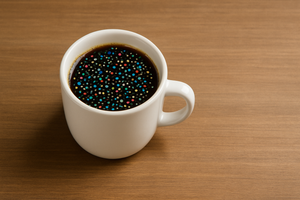Your morning coffee should wake you up, not load you with hidden toxins.
But the truth is, your daily brew is likely filled with microplastics — tiny fragments of plastic that can linger in your body for years, maybe even forever. They’ve already been found all over human bodies including people’s brains, where they can trigger inflammation and affect memory, and in reproductive tissue, where they may disrupt hormones and fertility.
Here is a diagram that reveals how microplastics affect different bodily systems:

On average, each of us consumes 39,000 to 52,000 particles of microplastics inadvertently through food and drink every year. That’s about a credit card of plastic every year. And coffee — the ritual many of us love the most — is one thing we can pay attention to in order to reduce this.
With a few intentional swaps, you can cut back on the plastic load in your cup and reclaim your ritual as something that supports your health instead of working against it.
1. Ditch single-use coffee pods
 Single-serve pods (like K-Cups) may be convenient, but they’re microplastic factories. Hot water and pressure pull billions of tiny plastic particles from the pod and into your drink. And the waste doesn’t end there — an estimated 56 billion pods end up in landfills every year, where they break down into even more microplastics that leach into waterways and circle right back to us.
Single-serve pods (like K-Cups) may be convenient, but they’re microplastic factories. Hot water and pressure pull billions of tiny plastic particles from the pod and into your drink. And the waste doesn’t end there — an estimated 56 billion pods end up in landfills every year, where they break down into even more microplastics that leach into waterways and circle right back to us.
Wondering what to do? The simplest solution is to trade pods for brewing methods that don’t rely on plastic. A French press, Chemex, Pourover, quality auto drip machine, or Moka Pot all take a little more intention, but the taste (and peace of mind) are worth it. They even make Glass Aeropress as of recent.
Best swaps:
-
French press or Chemex
-
Stainless steel reusable pods (if you can’t give up your machine)
-
Moka Pot for stovetop brewing
2. Avoid plastic mesh filters
 That reusable mesh filter in your drip brewer? It’s quietly breaking down every time hot water rushes through. Over months of daily use, that adds up to a lot of invisible plastic in your cup. Stainless steel and paper alternatives aren’t just safer — they often brew a smoother, cleaner cup as they trap more of the fine particles and oils that can give coffee a bitter edge.
That reusable mesh filter in your drip brewer? It’s quietly breaking down every time hot water rushes through. Over months of daily use, that adds up to a lot of invisible plastic in your cup. Stainless steel and paper alternatives aren’t just safer — they often brew a smoother, cleaner cup as they trap more of the fine particles and oils that can give coffee a bitter edge.

Best swaps:
-
Plastic free auto drip brewers such as The Plastic Free Coffee Brewer by Simply Good Coffee or the Fellow Aiden Precision Coffee brewer
-
Unbleached paper filters
-
Metal mesh pour-over
3. Skip plastic-lined disposable cups (PLA = PLASTIC)

Most paper coffee cups aren’t just paper. They’re lined with a thin PLA coating — a plant-based plastic made from corn starch or sugarcane. Even though it starts with plants, PLA is chemically processed into a polymer, which means it behaves like conventional plastic. Under heat, the lining can soften, flake, and shed microplastics into your drink, and in landfills it lingers just like petroleum plastic.
Think about that next time you grab a to-go latte. Instead, bring your own travel mug. It’s sturdier, keeps your drink hotter on a long commute, and helps reduce unnecessary plastic in your body (and in landfills). And they almost always give you a discount for your own mug (we know that we do).
Best swaps:
-
Stainless steel insulated mug
-
Ceramic travel mug
-
Glass tumbler with silicone sleeve
4. Swap plastic gear for sustainable solutions
Coffee gear hides plastic in sneaky places — inside kettles, grinder parts, even brewing chambers you rarely notice. The problem? Boiling water and constant friction wear those parts down, sending microplastics straight into your drink.
Switching to glass, ceramic, or stainless steel isn’t just safer — these materials last longer, preserve flavor, and often make brewing more enjoyable.
This goes for grinders, too. Plastic burrs can dull and shed over time, while ceramic or stainless burr grinders hold up better and produce a more consistent grind.



Best swaps:
-
Stainless steel kettle with minimal plastic fittings
5. Upgrade your coffee storage

Your beans deserve better than thin plastic bags after they arrive to your kitchen. Not only can plastic packaging leach particles into your coffee over time (especially in warm or humid spots), but the wrong container such as Tupperware could leach light, air, and moisture — the three biggest enemies of fresh coffee. Whole beans stored in stainless steel containers with a one way degassing valve stay flavorful longer, and they’re spared from the microplastics and subtle “plastic-y” notes that cheap packaging can add.
Best swaps:

6. Filter your water

Surprise twist: the biggest source of microplastics in your coffee might not be the cup or the pod — it’s the water itself. Researchers found that 83% of tap water worldwide contains plastic contaminants. And switching to bottled water isn’t the answer. Bottled water contamination is even worse, with studies finding up to 240,000 plastic particles per liter.
The fix? Filter it.
To reduce your exposure, consider filter options. A high-quality carbon or reverse osmosis system can knock down microplastic levels along with other contaminants. If you’re stuck with hard tap water, boiling before filtering can cut the load even further. And when you skip bottled water altogether, you’re not just protecting yourself — you’re cutting plastic waste at the source.

Best swaps:
-
Reverse osmosis filter system
-
Countertop carbon filter pitcher
-
Reusable water bottle (stainless or glass)

Filtered water isn’t just for coffee lovers. If tea is your thing, these solutions are perfect for you too. Just choose loose leaf or matcha over tea bags for a cleaner, lower-waste way to steep.
Reclaim your ritual
Microplastics are everywhere these days, but there are ways to reduce your exposure. Simple, intentional swaps can make your routine healthier and more sustainable. The problem is real, but the solutions are within reach — and every change helps protect both you and the planet.

If you’re rethinking your brewing ritual, why not rethink what’s in your mug too? Peak State’s regeneratively grown coffee is infused with functional mushrooms to support focus, immunity, and calm.


